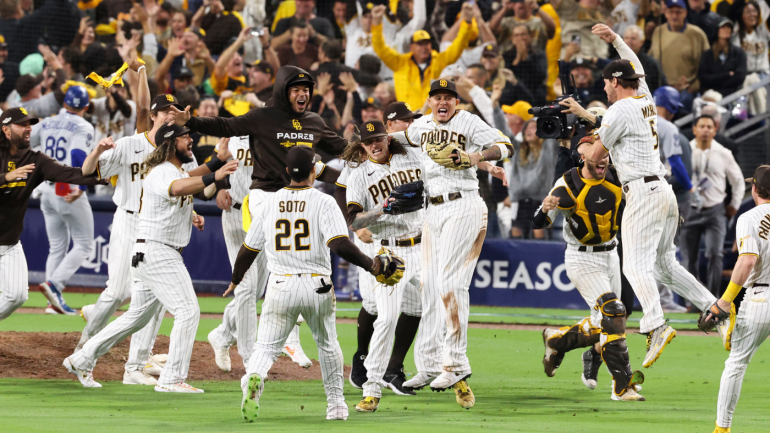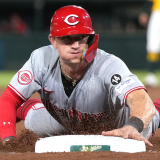Why MLB market size isn't an excuse for cheap teams – just look at the 'small market' Padres and Manny Machado
A segment of baseball fandom remains that believes MLB success is driven by market size. Don't believe it

Due in large part to the fact that Major League Baseball doesn't have a salary cap while the NFL, NBA and NHL do -- even if they aren't hard caps -- there's a sentiment baseball has been unable to shake for decades: market size is everything. That idea isn't solely due to the existence of the salary cap in other leagues, but it seems a driving factor in the process of so many sports fans deciding that in baseball, and baseball alone.
The other sports have so much more "parity," or so goes the line of thinking. In baseball, the "small market" teams simply can't keep their stars like smaller market teams do in other sports. I tackled the fallacy that other sports have more parity than Major League Baseball last February. Some of the numbers have changed, obviously, but it bears repeating that it simply isn't true to say MLB lags behind in the parity department. It's total nonsense.
As far as market sizes dictating things, it's complicated. Before moving further, let's first look at the actual market sizes so we have an idea of what we're dealing with.
Via sportsmediawatch, here are the U.S. markets with MLB teams ranked by size:
- New York (Yankees and Mets)
- Los Angeles area (Dodgers and Angels)
- Chicago (Cubs and White Sox)
- Philadelphia (Phillies)
- Dallas area (Rangers)
- Atlanta (Braves)
- Houston (Astros)
- Washington, D.C. (Nationals)
- Boston area (Red Sox)
- San Francisco/Oakland/San Jose (Giants and Athletics)
- Phoenix/Mesa/Tempe (Diamondbacks)
- Seattle (Mariners)
- Tampa/St. Petersburg (Rays)
- Detroit (Tigers)
- Minneapolis/St. Paul (Twins)
- Denver (Rockies)
- Miami/Fort Lauderdale (Marlins)
- Cleveland/Akron (Guardians)
- St. Louis (Cardinals)
- Pittsburgh (Pirates)
- Baltimore (Orioles)
- San Diego (Padres)
- Kansas City (Royals)
- Cincinnati (Reds)
- Milwaukee (Brewers)
Toronto is a pretty big market and at this point has most of Canada. It's hard to know exactly where to slot them but it isn't small.
Keep in mind these are television markets and it's possible we could do some adjusting to account for the market size impacting resources available to each team. For example, the Red Sox are a monster market, as their audience includes all of New England. We all know the Yankees are a mega-mega market with a fan base pretty much everywhere and even with Steve Cohen running the Mets, I think it's fair to say the Bombers are a larger market team than their Big Apple neighbors.
In general, though, it's a decent picture of where teams rank in terms of how big a market they serve. Using "market" is a much better idea than grabbing city populations. Just as an example, San Diego has a higher population than Boston, but, again, Boston has so much more than just Boston when we're talking about a market for a fan base. San Diego essentially just has San Diego. That matters.
Keeping this in mind and trying to be fair with where the Blue Jays should fall, we can probably sort large market, middle market and small market teams like so:
Large (10): Yankees, Mets, Dodgers, Angels, Cubs, White Sox, Phillies, Rangers, Braves, Red Sox
Middle (10): Astros, Blue Jays, Nationals, Giants, A's, Diamondbacks, Mariners, Rays, Tigers, Twins
Small (10): Rockies, Marlins, Guardians, Cardinals, Pirates, Orioles, Padres, Royals, Reds, Brewers
Obviously, we could nitpick how much money teams actually have at their disposal within those tiers. We could probably separate out the Yankees, Mets and Dodgers into megamarket teams (I'd argue there's no reason the Cubs shouldn't be there and at that point we should include the Angels and White Sox, no?). I jumped Boston up because, if anything, the Red Sox are more megamarket than middle. Still, among the teams listed as middle market, the Astros, Jays and at least Giants can spend with the likes of the Phillies, Rangers and Braves, so there isn't much separation there. There are complications with teams like the A's and Rays among so-called middle-market teams, but also, the Rockies and Cardinals from "small" markets seem just fine to outspend teams in larger markets.
All this is to say, it's not a hard-slotting system and there's plenty of context behind where any team would be slotted even if it were.
Still, in this measure, only three teams are in smaller markets than the Padres.
Remember the Padres, who signed Manny Machado to a 10-year, $300 million contract? If we're running with the narrative that small-market teams (like those poor Orioles) can't keep their players, how does Machado end up with a "smaller" market team? The Padres didn't screw themselves out of future transactions there, either, since they just grabbed Xander Bogaerts for 11 years and $280 million. In between, they traded for superstar Juan Soto and signed Fernando Tatis, Jr. to a 14-year, $340 million extension. I could go on and on, because it's far more than just these deals with the Padres.
If market size is the driving factor in baseball economics, what is going on here?
The answers vary by team, obviously, but most of the small-market teams that haven't had success in recent years can point to themselves. It's player development (or lack thereof) and ownership.
The Twins are on the back-end of the middle-market teams and it could be argued they are a small-market club. Yet they were able to keep superstar catcher Joe Mauer throughout his career. They also signed superstar shortstop Carlos Correa (twice) after he was drafted and developed by a large-market team.
The Reds never lost Joey Votto to free agency and they have ownership who loves to cry poor.
The Brewers, playing in the smallest market in baseball, kept Ryan Braun throughout his career. They signed Lorenzo Cain in free agency. They traded for Christian Yelich and then extended him to the tune of nine years and $215 million. They also made the playoffs four straight years before having the best non-playoff record last season at 86-76.
We could keep going. Those weren't cherry-picked examples. Joe Sheehan in his newsletter back in late January went through a large number of players who stayed in town. Of the $200 million-plus deals in baseball history, it broke down with 13 signing to a large-market team, 10 to a middle-market team and (gasp!) eight to a small-market team. He also went through a list of the top 33 by players this century and showed the journey of each through the league. There is no pattern whatsoever of wide-scale small-to-large market movement. There just isn't.
Further, Major League Baseball as a whole is swimming in an obscene amount of money (MLB set a revenue record in 2022, via Forbes) and much of that money is flowing toward smaller-market teams.
- There's revenue sharing, which directly takes from the richest teams and gives to "poor" (read: simply less rich) teams.
- There are the national TV deals, which, according to Forbes, are worth $1.76 billion to the league annually while the streaming deals (Apple+ and Peacock) are worth an additional $115 million a year. That's all on top of local deals.
- MLB sold the remainder of BAMTech to Disney last November, another windfall that resulted in $900 million being dispersed to the 30 MLB teams. This was at least the third -- and smallest, per reports -- payment from Disney to acquired the software development company from MLB and NHL that benefitted every MLB team.
I've seen at least one serious estimation that between this and other money coming in, the smallest-market teams can expect around $100 million before selling a single ticket in spring training or the regular season.
And look, there's overhead. There are plenty of expenses and headaches that come with owning a Major League Baseball team. I'm not going to sit here and attempt to estimate how much money any particular team has and should dedicate to player payroll, primarily because the very teams crying poor have long refused to make their accounting books public. They aren't required to do so, of course, but if I were a fan of a small-market team, I sure wouldn't be giving them the benefit of the doubt instead of asking them to give us a real reason to trust them (Orioles CEO John Angelos' promise to "show you the financials" a week after his Martin Luther King Jr. Day meltdown never came to fruition).
The funny thing is, those owners have had it so good for years in the public eye. For a while, all the ire was directed at the highest-paid players for being the "greedy" ones and the bad guys. The cool thing to do was to talk about how easily you could construct a team under a low payroll. It was a badge of honor to root for teams that could win with low payrolls and if, say, the Yankees won the World Series, the common retort was akin to "lol they bought a championship."
There's still plenty of that out there, but there's also a wave of change coming. There always will be -- and should be -- an emphasis on smart spending, just as long as there's a goal in sight. The first goal is to win. The second is to spend enough and make the right moves to earn the trust and patronage of its fan base. Plenty of fans are wising up and have stopped buying the owner-level excuses of poverty.
Owners have every right to run their business as they see fit. They are, after all, the owners. I will submit, however, that if there is an owner out there proclaiming that his/her group can't afford to keep up with the salaries in Major League Baseball, there's a very simple answer: Put the team up for sale. Every single team sale in major professional sports results in a veritable killing for the previous owner. Remember the small market that is Kansas City? David Glass bought the team for $96 million in 2000 and sold it for $1 billion in 2019.
The latest culprit for the naysayers of spending is Mets owner Steve Cohen. He told ESPN the following, regarding complaints he's gotten from fellow owners.
"I've heard what everyone else has heard: that they're not happy with me. I hear things from people who are maybe more neutral -- that they're taking a lot of heat from their fans. I kind of look at that like, you're looking at the wrong person. They're putting it on me. Maybe they need to look more at themselves.
"I'm not responsible for how other teams run their clubs."
Steve Cohen wants to take care of his fan base and some other owners are angry it makes them look bad. Good.
Yes, there's been a sea change in recent years and hopefully it continues. A good number of fans have grown tired of owner excuses and would rather see more owners like the Mets and Padres have.
Cohen, with his estimated net worth around $17 billion, can afford to do whatever he wants. The Padres' Peter Seidler, worth a paltry $3 billion, can too. But so can everyone else. And those who choose not to pay nine figures to the next free agent superstar must, for the sake of their team, find other ways to win. Fans rightfully no longer accept that there isn't enough money. Get better at player development and we can stop worrying about fictional problems such like a lack of "parity" and how supposedly small-market teams are simply feeders for the Yankees and Dodgers.


















